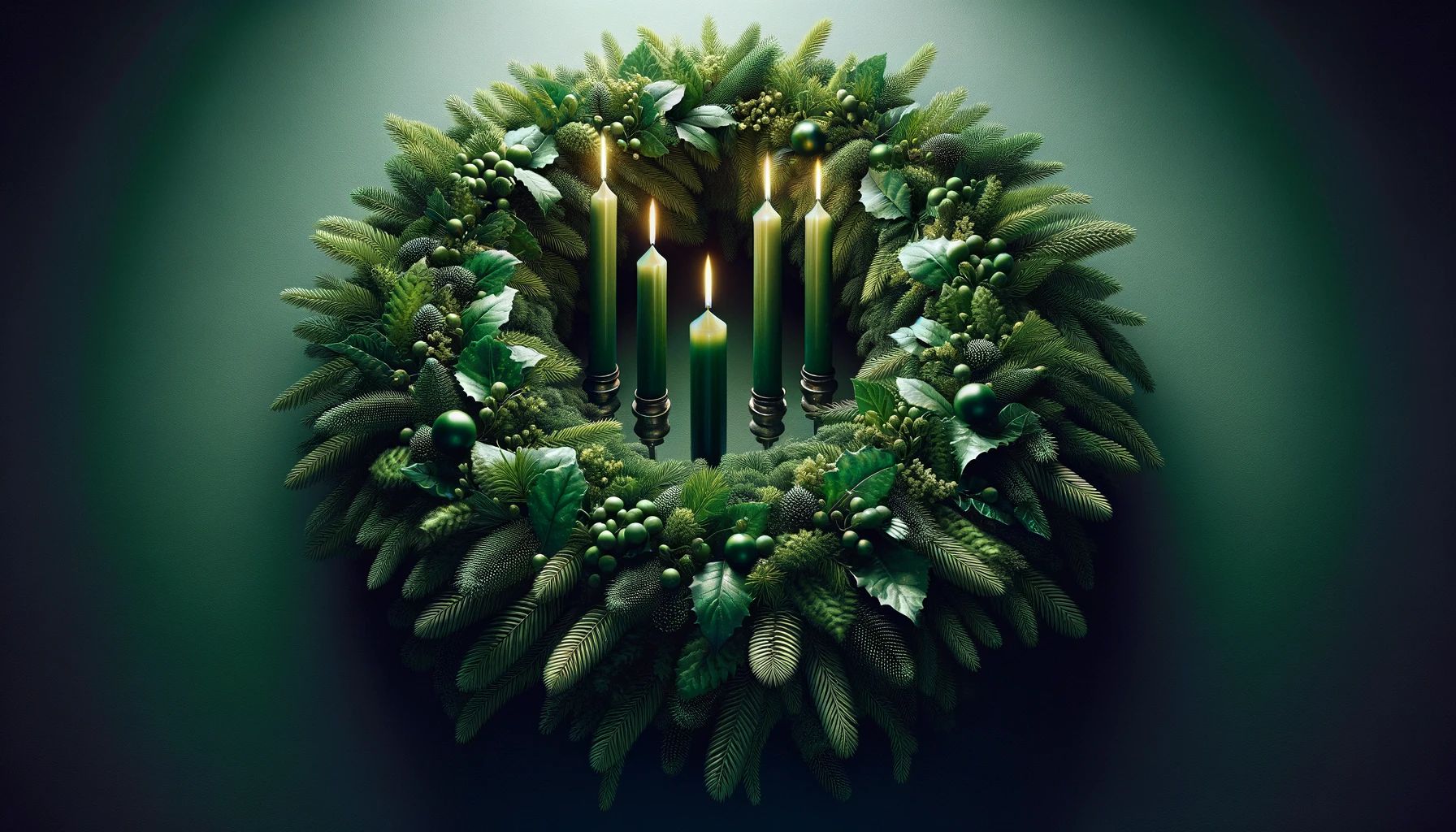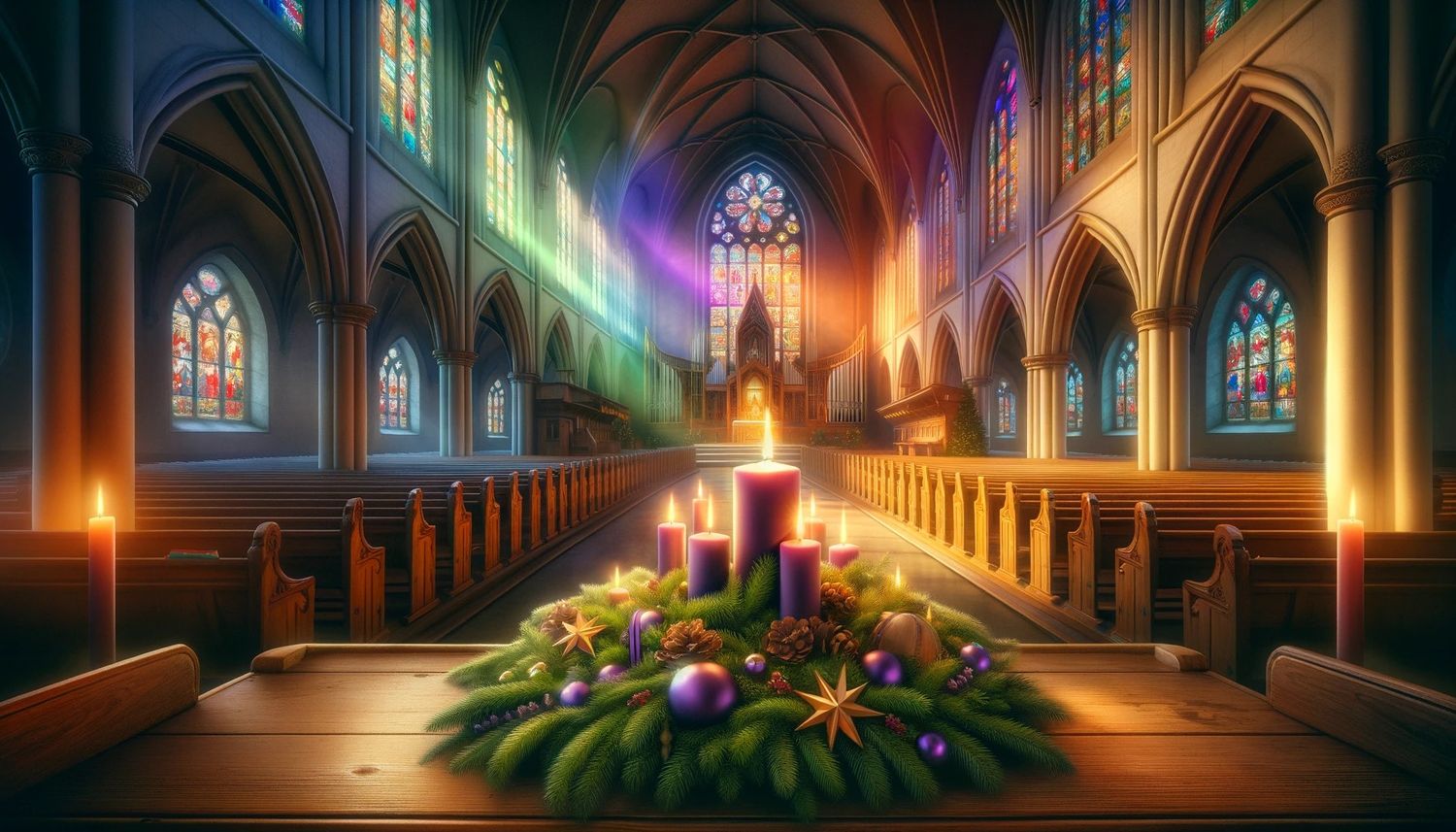Home>Special Themes>What Are The Symbols Of Advent Wreath


Special Themes
What Are The Symbols Of Advent Wreath
Published: February 14, 2024
Jason DeRose, Managing Editor at Christian.net, uses his expertise in religion and journalism to deepen understanding of faith's societal impacts. His editorial leadership, coupled with a strong academic background, enriches the platform’s diverse content, earning him recognition in both journalism and religious circles.
Discover the symbols of the Advent wreath and their special themes. Learn about the significance of each symbol in the Advent season.
(Many of the links in this article redirect to a specific reviewed product. Your purchase of these products through affiliate links helps to generate commission for Christian.net, at no extra cost. Learn more)
Table of Contents
Introduction
The Advent wreath is a cherished symbol of the Advent season, a time of preparation and anticipation leading up to the joyous celebration of Christmas. This beautiful tradition has deep roots in Christian history and is observed by millions of people around the world. The Advent wreath serves as a powerful visual reminder of the spiritual significance of this season, and its symbols hold profound meaning for those who partake in its observance.
The Advent wreath is a timeless emblem of hope, faith, love, and joy, and its presence in homes, churches, and communities fosters a sense of unity and spiritual connection. As we delve into the history, meaning, and symbols of the Advent wreath, we will uncover the rich tapestry of traditions and beliefs that have woven this symbol into the fabric of the holiday season.
Read more: What Does The Advent Wreath Symbolizes
History of Advent Wreath
The history of the Advent wreath dates back to the early 19th century in Germany, where Lutherans and Catholics sought a visual way to mark the weeks leading up to Christmas. The concept of the Advent wreath evolved from the tradition of lighting candles during the dark winter months as a symbol of hope and light. The circular shape of the wreath, which has no beginning or end, represents eternity and the unending love of God.
The original Advent wreath was a simple wooden wheel adorned with small white candles. Over time, the design of the wreath evolved, and it became customary to use evergreen branches to symbolize eternal life and the everlasting presence of God. The tradition of lighting a candle on each Sunday of Advent gradually emerged, with each candle representing a different aspect of the spiritual preparation for Christmas.
The Advent wreath gained popularity in the 20th century and spread beyond Germany to other parts of Europe and eventually to the United States and other countries around the world. Today, the Advent wreath is a widely recognized and cherished symbol of the holiday season, embraced by various Christian denominations and celebrated in diverse cultural settings.
As the tradition of the Advent wreath has continued to evolve, different interpretations and customs have emerged, adding depth and richness to its symbolism. While the specific details of its history may vary among different regions and religious traditions, the central themes of hope, faith, love, and joy remain at the heart of the Advent wreath's significance.
The history of the Advent wreath serves as a testament to the enduring power of tradition and the universal human desire to find meaning and connection in the rhythms of the natural world and the passage of time. This timeless symbol continues to inspire and unite people of faith, offering a beacon of light and hope during the Advent season and beyond.
Meaning of Advent Wreath
The Advent wreath holds profound significance, encapsulating the essence of the Advent season and serving as a poignant symbol of spiritual preparation and anticipation. At its core, the Advent wreath embodies the timeless themes of hope, faith, love, and joy, offering a visual representation of the spiritual journey leading up to the celebration of Christmas.
The circular shape of the wreath symbolizes eternity and the unending love of God. It serves as a powerful reminder of the eternal nature of God's love and the promise of new beginnings. The evergreen branches used to construct the wreath represent the enduring presence of life, even in the midst of winter's dormancy, and serve as a metaphor for the everlasting life offered through faith.
The lighting of the candles on the Advent wreath corresponds to the four Sundays leading up to Christmas. Each candle represents a different aspect of the spiritual preparation for the birth of Christ. The first candle, often called the "Prophet's Candle" or "Hope Candle," symbolizes the anticipation of the coming Messiah and the hope that Christ's birth brings to the world.
The second candle, known as the "Bethlehem Candle" or "Preparation Candle," signifies the preparation and readiness for the arrival of the Christ child. It represents the journey of Mary and Joseph to Bethlehem and the humble circumstances surrounding the birth of Jesus.
The third candle, referred to as the "Shepherd's Candle" or "Joy Candle," embodies the joy and celebration that accompany the announcement of Christ's birth. It serves as a joyful proclamation of the good news brought by the angels to the shepherds in the fields.
The fourth candle, often called the "Angel's Candle" or "Love Candle," represents the love of God manifested through the gift of His Son to the world. It symbolizes the profound love that permeates the Christmas story and serves as a poignant reminder of the ultimate expression of divine love.
As a whole, the Advent wreath encapsulates the journey of faith and spiritual preparation, guiding individuals and communities through a period of reflection, anticipation, and celebration. Its symbols and rituals offer a tangible way to engage with the deeper meanings of the Advent season, fostering a sense of unity and spiritual connection among those who partake in its observance.
The Advent wreath, with its rich symbolism and timeless significance, continues to inspire and uplift individuals and communities, serving as a beacon of light and hope during the Advent season and beyond.
Symbols of Advent Wreath
The symbols of the Advent wreath are deeply rooted in Christian tradition and hold profound spiritual significance. Each element of the wreath, from the circular shape to the candles and greenery, carries symbolic meaning that enriches the observance of the Advent season.
The Wreath
The circular shape of the Advent wreath represents eternity and the unending love of God. It serves as a powerful reminder of the eternal nature of God's love and the promise of new beginnings. The evergreen branches used to construct the wreath symbolize the enduring presence of life, even in the midst of winter's dormancy. This serves as a metaphor for the everlasting life offered through faith.
The Candles
The candles on the Advent wreath are lit sequentially on each of the four Sundays leading up to Christmas. Each candle represents a different aspect of the spiritual preparation for the birth of Christ. The first candle, often called the "Prophet's Candle" or "Hope Candle," symbolizes the anticipation of the coming Messiah and the hope that Christ's birth brings to the world. The second candle, known as the "Bethlehem Candle" or "Preparation Candle," signifies the preparation and readiness for the arrival of the Christ child. The third candle, referred to as the "Shepherd's Candle" or "Joy Candle," embodies the joy and celebration that accompany the announcement of Christ's birth. The fourth candle, often called the "Angel's Candle" or "Love Candle," represents the love of God manifested through the gift of His Son to the world.
The Colors
The colors of the candles also carry symbolic significance. The traditional colors used in the Advent wreath are purple and pink, with a white candle often placed in the center. The purple candles symbolize penitence and preparation, reflecting the solemn introspection and repentance associated with the Advent season. The pink candle represents joy and is typically lit on the third Sunday of Advent, known as Gaudete Sunday, a day of rejoicing in anticipation of the coming Christmas celebration. The white candle, if included, is often lit on Christmas Day, symbolizing the purity and light of Christ.
The Greenery
The use of evergreen branches in the Advent wreath symbolizes eternal life and the everlasting presence of God. The vibrant greenery serves as a visual reminder of the hope and renewal found in Christ, even in the midst of the winter season. The aromatic nature of the evergreen also evokes a sense of vitality and freshness, symbolizing the enduring life and vitality offered through faith in Christ.
In summary, the symbols of the Advent wreath offer a rich tapestry of spiritual significance, guiding individuals and communities through a period of reflection, anticipation, and celebration. Each element of the wreath, from the circular shape to the candles and greenery, serves as a poignant reminder of the timeless themes of hope, faith, love, and joy that define the Advent season.
The Wreath
The Advent wreath, with its distinctive circular shape, serves as a powerful symbol of eternity and the unending love of God. The circular form of the wreath has no beginning or end, representing the timeless nature of God's love and the promise of new beginnings. This enduring symbolism resonates deeply with individuals and communities as they engage in the spiritual journey of the Advent season.
The use of evergreen branches to construct the Advent wreath holds profound significance. Evergreens, with their vibrant foliage that remains green throughout the year, symbolize the enduring presence of life, even in the midst of winter's dormancy. This serves as a poignant metaphor for the everlasting life offered through faith in Christ. The lush greenery of the Advent wreath evokes a sense of vitality and renewal, reminding believers of the hope and new life found in Christ.
In addition to symbolizing eternal life, the evergreen branches also reflect the everlasting presence of God. As the natural world transitions into the winter season, the evergreen foliage stands as a testament to the enduring nature of God's love and the constancy of His presence. The aromatic nature of the evergreen further enhances the sensory experience, infusing the surrounding space with a sense of vitality and freshness.
The circular shape and evergreen construction of the Advent wreath serve as tangible reminders of the spiritual truths and promises that underpin the Advent season. As individuals and families gather around the wreath to light the candles and engage in moments of reflection and prayer, the presence of the wreath becomes a focal point for contemplation and spiritual connection.
Overall, the Advent wreath, with its timeless symbolism and visual beauty, continues to inspire and uplift those who partake in its observance. The circular form and evergreen components of the wreath offer a tangible representation of the enduring love, hope, and renewal found in the Advent season, fostering a sense of unity and spiritual connection among believers.
Read more: What Is The Symbol Of Advent?
The Candles
The candles on the Advent wreath play a central role in the observance of the Advent season, symbolizing the progression of spiritual preparation and anticipation leading up to the celebration of Christmas. Each candle holds deep symbolic significance, representing different aspects of the Advent journey and the profound themes of hope, faith, love, and joy.
The lighting of the candles on the Advent wreath occurs sequentially on each of the four Sundays leading up to Christmas. This ritual marks the passage of time and serves as a visual representation of the spiritual progression toward the birth of Christ. The first candle, often referred to as the "Prophet's Candle" or "Hope Candle," symbolizes the anticipation of the coming Messiah and the hope that Christ's birth brings to the world. As the first candle is lit, it illuminates the path of spiritual preparation, guiding individuals and communities in their reflections on the promise of redemption and renewal.
The second candle, known as the "Bethlehem Candle" or "Preparation Candle," signifies the preparation and readiness for the arrival of the Christ child. It represents the journey of Mary and Joseph to Bethlehem and the humble circumstances surrounding the birth of Jesus. The gentle glow of the second candle serves as a reminder of the humble beginnings of the Christmas story and the quiet anticipation of the miraculous event that is about to unfold.
The third candle, often referred to as the "Shepherd's Candle" or "Joy Candle," embodies the joy and celebration that accompany the announcement of Christ's birth. Its radiant flame symbolizes the joyous proclamation of the good news brought by the angels to the shepherds in the fields. As the third candle is lit, it infuses the surroundings with a sense of warmth and jubilation, inviting individuals to rejoice in the imminent arrival of the Savior.
The fourth candle, often called the "Angel's Candle" or "Love Candle," represents the love of God manifested through the gift of His Son to the world. Its flickering flame serves as a poignant reminder of the profound love that permeates the Christmas story and the ultimate expression of divine love found in the birth of Jesus. As the fourth candle is lit, it symbolizes the culmination of the Advent journey, leading to the fullness of love and the promise of redemption realized in the birth of Christ.
In summary, the candles of the Advent wreath guide individuals and communities through a period of spiritual reflection, anticipation, and celebration. Their symbolic illumination serves as a tangible representation of the timeless themes of hope, faith, love, and joy that define the Advent season, fostering a sense of unity and spiritual connection among those who partake in its observance.
The Colors
The colors of the candles used in the Advent wreath hold deep symbolic significance, enriching the visual and spiritual experience of the Advent season. Traditionally, the candles are adorned in shades of purple and pink, with the potential inclusion of a central white candle, each color carrying its own profound meaning.
The use of purple candles in the Advent wreath symbolizes penitence and preparation. Purple has long been associated with introspection, repentance, and spiritual readiness, reflecting the solemn and contemplative nature of the Advent season. As the first and second candles, representing hope and preparation, are lit, the deep hue of the purple candles serves as a visual reminder of the spiritual journey toward the celebration of Christ's birth. It prompts individuals to engage in moments of introspection and repentance, preparing their hearts and minds for the joyous arrival of Christmas.
The pink candle, often lit on the third Sunday of Advent, known as Gaudete Sunday, introduces a vibrant and joyful element to the Advent wreath. The pink color symbolizes joy and rejoicing, marking a shift in the tone of the season as the anticipation of Christmas intensifies. The radiant glow of the pink candle embodies the spirit of celebration and anticipation, inviting individuals to embrace the imminent arrival of the Savior with a sense of joy and exuberance.
In some traditions, a white candle is placed in the center of the Advent wreath, representing the purity and light of Christ. The white color signifies the culmination of the Advent journey, leading to the celebration of the birth of Jesus on Christmas Day. Its luminous presence amidst the surrounding purple and pink candles serves as a visual representation of the purity and divinity embodied in the Christ child, illuminating the path toward the fulfillment of God's promise and the arrival of redemption and hope.
The colors of the candles in the Advent wreath, with their rich symbolism and visual allure, enhance the observance of the Advent season, guiding individuals and communities through a period of reflection, anticipation, and celebration. As the candles are sequentially lit, their colors serve as poignant reminders of the timeless themes of hope, faith, love, and joy that define the Advent season, fostering a sense of unity and spiritual connection among those who partake in its observance.
The Greenery
The use of evergreen branches in the construction of the Advent wreath holds profound symbolic significance, enriching the visual and spiritual experience of the Advent season. Evergreens, with their lush and vibrant foliage that remains green throughout the year, serve as a powerful representation of the enduring presence of life, even in the midst of winter's dormancy. This timeless symbolism resonates deeply with individuals and communities as they engage in the spiritual journey of the Advent season.
The choice of evergreen branches is deeply rooted in Christian tradition, symbolizing eternal life and the everlasting presence of God. As the natural world transitions into the winter season, the evergreen foliage stands as a testament to the enduring nature of God's love and the constancy of His presence. The aromatic nature of the evergreen further enhances the sensory experience, infusing the surrounding space with a sense of vitality and freshness.
The vibrant greenery of the Advent wreath serves as a visual reminder of the hope and renewal found in Christ, even in the midst of the winter season. The lush foliage represents the promise of new life and growth, mirroring the spiritual transformation and rejuvenation that accompany the anticipation of the birth of Jesus. As individuals and families gather around the wreath adorned with evergreen branches, they are invited to reflect on the enduring hope and vitality offered through faith in Christ.
The use of evergreen branches in the Advent wreath also evokes a sense of continuity and connection with the natural world. As the seasons change and the landscape transitions into winter, the presence of the evergreen foliage serves as a poignant reminder of the cyclical nature of life and the enduring presence of God's love throughout the changing seasons. This connection to the rhythms of nature enhances the symbolic depth of the Advent wreath, fostering a sense of unity and spiritual connection among believers.
In summary, the vibrant greenery of the Advent wreath, with its enduring symbolism and visual beauty, serves as a tangible representation of the hope, renewal, and enduring presence of God found in the Advent season. The lush evergreen branches enrich the observance of the Advent season, guiding individuals and communities through a period of reflection, anticipation, and spiritual connection.
Conclusion
The Advent wreath stands as a timeless symbol of hope, faith, love, and joy, weaving together centuries of tradition and spiritual significance. As we conclude our exploration of the history and symbols of the Advent wreath, it becomes evident that this cherished emblem serves as a beacon of light and inspiration during the Advent season and beyond.
The rich history of the Advent wreath, originating in 19th-century Germany and evolving into a widely embraced tradition, reflects the universal human longing for connection, meaning, and spiritual preparation. The enduring symbolism of the circular wreath, adorned with evergreen branches and candles, resonates across diverse cultures and denominations, uniting individuals and communities in a shared journey of faith and anticipation.
The profound meaning embedded in the symbols of the Advent wreath, from the circular shape representing eternity to the vibrant greenery symbolizing renewal, offers a tangible way to engage with the deeper themes of the Advent season. The sequential lighting of the candles, each representing a different aspect of spiritual preparation, guides individuals through a period of reflection, anticipation, and celebration, fostering a sense of unity and spiritual connection.
As the Advent wreath takes its place in homes, churches, and communities, it serves as a visual reminder of the enduring love of God and the promise of new beginnings. The vibrant greenery and flickering candles infuse the surroundings with a sense of vitality and hope, inviting individuals to embrace the timeless truths and promises of the Advent season.
In conclusion, the Advent wreath continues to inspire and uplift individuals and communities, offering a tangible representation of the spiritual journey leading up to the celebration of Christmas. Its symbols and rituals provide a framework for engaging with the deeper meanings of the Advent season, fostering a sense of unity and spiritual connection among those who partake in its observance. As we embrace the timeless traditions and symbols of the Advent wreath, we are reminded of the enduring hope, faith, love, and joy that define the Advent season, illuminating our path toward the celebration of the birth of Christ.













